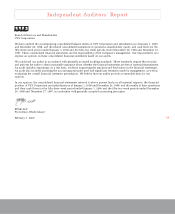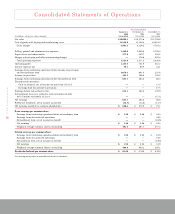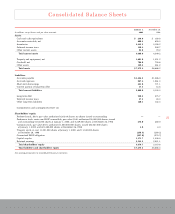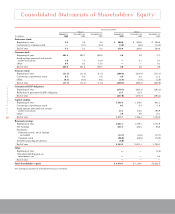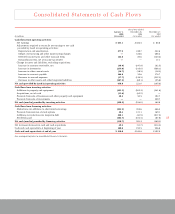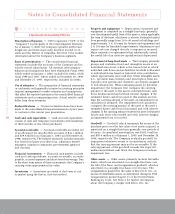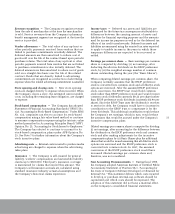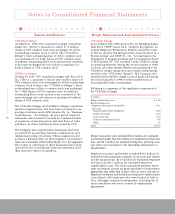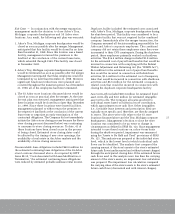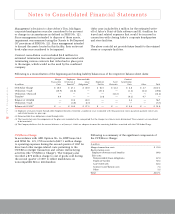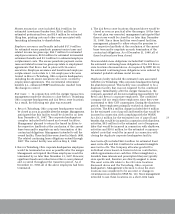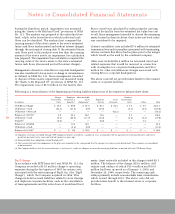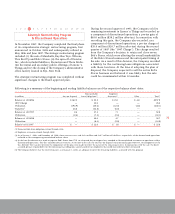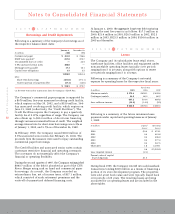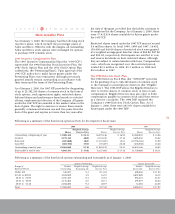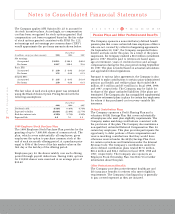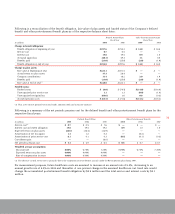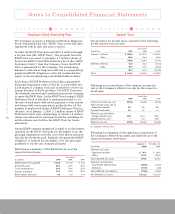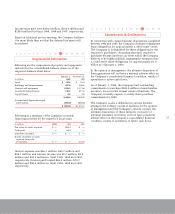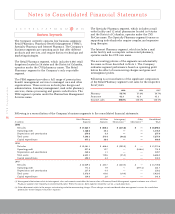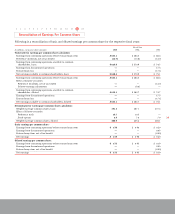CVS 1999 Annual Report Download - page 31
Download and view the complete annual report
Please find page 31 of the 1999 CVS annual report below. You can navigate through the pages in the report by either clicking on the pages listed below, or by using the keyword search tool below to find specific information within the annual report.
29
Merger transaction costs included $22.0 million for
estimated investment banker fees, $10.0 million for
estimated professional fees, and $3.0 million for estimated
filing fees, printing costs and other costs associated with
furnishing information to shareholders.
Employee severance and benefits included $17.0 million
for estimated excess parachute payment excise taxes and
related income tax gross-ups, $53.7 million for estimated
employee severance, $18.0 million for estimated incremental
retirement benefits and $1.1 million for estimated employee
outplacement costs. The excess parachute payment excise
taxes and related income tax gross-ups relate to employment
agreements that Revco had in place with 26 senior
executives. Employee severance and benefits and employee
outplacement costs relate to 1,195 employees who were
located in Revco’s Twinsburg, Ohio corporate headquarters,
including the 26 senior executives who were covered by
employment agreements. The incremental retirement
benefits (i.e., enhanced SERP benefits) also resulted from
the change in control.
Exit Costs ~ In conjunction with the merger transaction,
management made the decision to close Revco’s Twinsburg,
Ohio corporate headquarters and 223 Revco store locations.
As a result, the following exit plan was executed:
1. Revco’s Twinsburg, Ohio corporate headquarters would
be closed as soon as possible after the merger. Management
anticipated that this facility would be closed by no later
than December 31, 1997. The corporate headquarters
complex included both leased and owned facilities.
Management planned to return the leased facilities to
the respective landlords at the conclusion of the current
lease term and/or negotiate an early termination of the
contractual obligations. Management intended to sell the
owned facility. These facilities were closed in March 1998.
The related continuing lease obligations extend through
2007. The owned facility was sold on May 8, 1998.
2. Revco’s Twinsburg, Ohio corporate headquarters employees
would be terminated as soon as possible after the merger.
Management anticipated that these employees would be
terminated by no later than December 31, 1997. However,
significant headcount reductions at Revco were planned
and occurred throughout the transition period. As of
December 31, 1998, all of the above employees had been
terminated.
3. The 223 Revco store locations discussed above would be
closed as soon as practical after the merger. At the time
the exit plan was executed, management anticipated that
these stores would be closed by no later than December
31, 1998. Since these facilities were leased facilities,
management planned to either return the premises to
the respective landlords at the conclusion of the current
lease term and/or negotiate an early termination of the
contractual obligations. As of December 31, 1998, all of
these locations have been closed.
Noncancelable lease obligations included $67.0 million for
the estimated continuing lease obligations of the 223 Revco
store locations discussed above. As required by EITF 88-10,
the estimated continuing lease obligations were reduced by
estimated probable sublease rental income.
Duplicate facility included the estimated costs associated
with Revco’s Twinsburg, Ohio corporate headquarters during
the shutdown period. This facility was considered to be a
duplicate facility that was not required by the combined
company. Immediately after the merger transaction, the
Company assumed all decision-making responsibility for
Revco and Revco’s corporate employees. The combined
company did not retain these employees since they were
incremental to their CVS counterparts. During the shutdown
period, these employees primarily worked on shutdown
activities. The $50.2 million charge included $10.4 million
for the estimated cost of payroll and benefits that would be
incurred in connection with complying with the WARN
Act, $13.3 million for the estimated cost of payroll and
benefits that would be incurred in connection with shutdown
activities, $8.5 million for the estimated cost of temporary
labor that would be incurred in connection with shutdown
activities and $18.0 million for the estimated occupancy-
related costs that would be incurred in connection with
closing the duplicate corporate headquarters facility.
Asset write-offs included $40.3 million for estimated fixed
asset write-offs and $41.9 million for estimated intangible
asset write-offs. The Company allocates goodwill to
individual stores based on historical store contribution,
which approximates store cash flow. Other intangibles (i.e.,
favorable lease interests and prescription files) are typically
store specific and, therefore, are directly assigned to stores.
The asset write-offs relate to the 223 store locations
discussed above and the Twinsburg, Ohio corporate
headquarters. Management’s decision to close the store
locations was considered to be an event or change in
circumstances as defined in SFAS No. 121. Since management
intended to use these locations on a short-term basis


